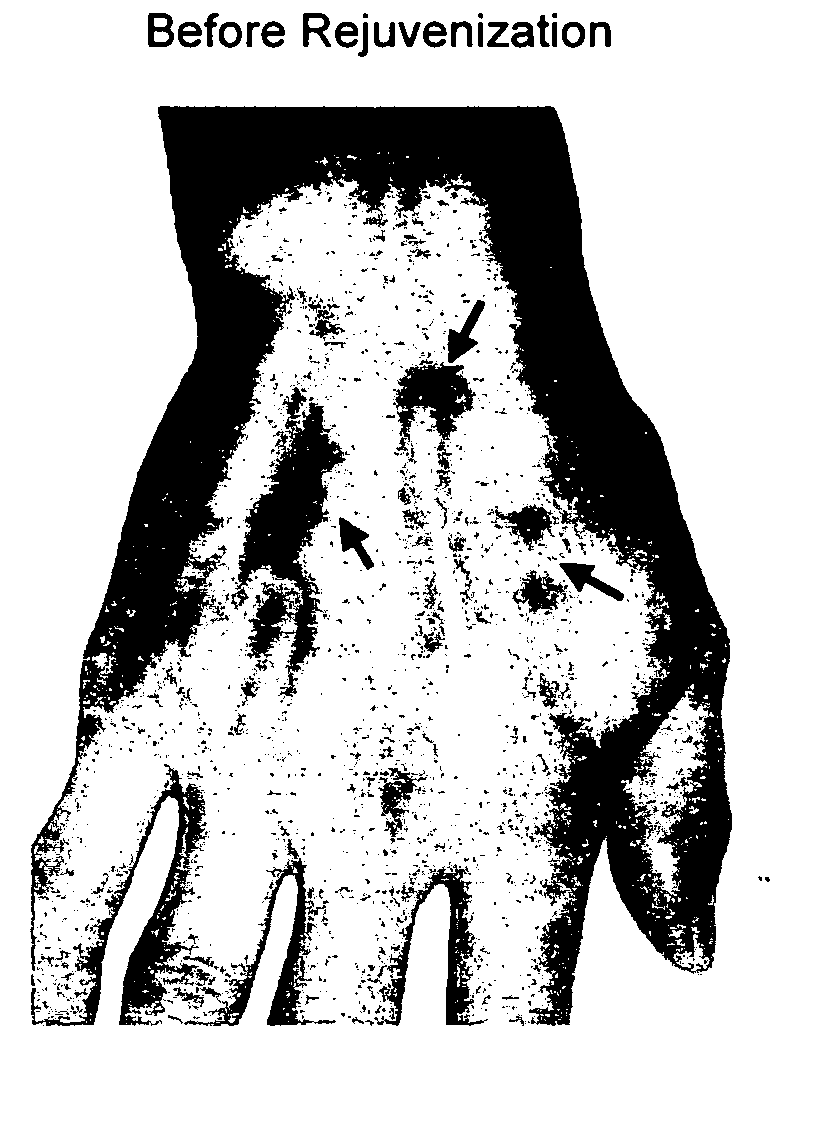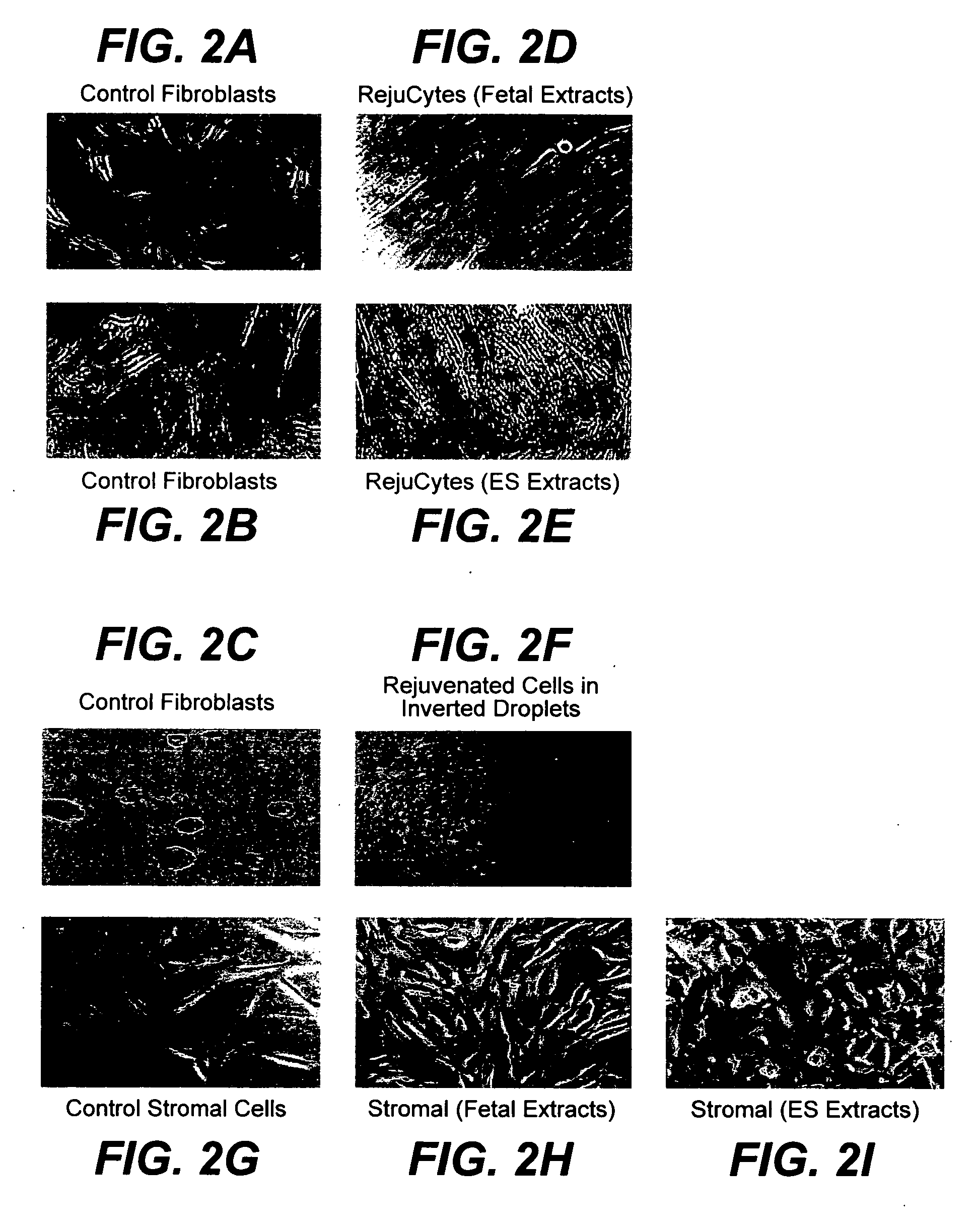Methods for rejuvenating cells in vitro and in vivo
a technology of rejuvenating cells and in vitro and in vivo, which is applied in the field of human clinical methods of rejuvenating cells, can solve the problems of increasing homeostatic imbalance, reducing cell function, and declining the ability to respond to stress
- Summary
- Abstract
- Description
- Claims
- Application Information
AI Technical Summary
Benefits of technology
Problems solved by technology
Method used
Image
Examples
example 1
Culturing Skin Fibroblasts
[0078] After sterilization, a skin biopsy (2 mm2) was cut from the inner forearm of a male volunteer aged 49 years. The skin biopsy was cut into several small pieces with a sterilized razor and directly placed into a 6-well plate, where it was covered with a thin layer of DMEM medium (Invitrogen, Carlsbad, Calif.), supplemented with 10% fetal bovine serum (FBS) and 100 U / mL of penicillin and 100 μg / mL of streptomycin, and grown at 37° C. in room air supplemented with 5% CO2. The medium was replaced with fresh DMEM daily.
[0079] After approximately 2 wk of incubation, fibroblasts had begun to grow around the skin edges. Fibroblasts were detached with 1× trypsin-EDTA (Invitrogen). The trypsin / fibroblast solution was centrifuged at 1200 rpm for 3 min. The fibroblast pellet was resuspended and the cells were counted. Depending on the count, the cells were seeded in a new 6- or 24-well plate in DMEM medium. The fibroblasts were collected and transferred to 75 m...
example 2
Culturing Blood or Bone Marrow Cells
[0080] The success in bone marrow transplantations declines with age, so one can infer that younger (neonatal) cells are preferable for hematopoietic reconstitution. Similarly, aging is also an important determinant of the growth of bone marrow stromal cells in cell culture. The stromal cells isolated from aged mice grow much more slowly than those isolated from young mice. It is thus desirable to rejuvenate aged bone marrow cells in vitro before they are used in cell replacement therapy.
[0081] White blood cells provide a quick and convenient source of terminally differentiated cells that can be used for in vitro rejuvenation. A 10 mL blood sample was collected using sodium heparin as the anticoagulant and was added to a 15 mL tube and diluted in four volumes of phosphate-buffered saline (PBS) containing EDTA (3 mM). The diluted blood was loaded onto Ficoll-Hypaque medium (Sigma, St. Louis Mo.) in a 50-mL conical tube and centrifuged at 400 rpm ...
example 3
Preparation of Fetal Extracts as the Rejuvenating Factor
[0082] Tissues collected in the early stages of development (e.g., fetus and embryo) are excellent sources of rejuvenating factors for rejuvenating cells. The following example of mouse fetal liver illustrates the procedure.
[0083] A fetus was collected from a pregnant mouse and the fetal liver was dissected into a Petri dish containing ice-cold PBS. The liver tissue was minced with sterile scissors or razors into small pieces, which were transferred with PBS into a glass homogenizer. The liver tissue was homogenized as the pestle gently moved up and down about 20 times. The cells were passed through a nylon layer to remove fibrous connective tissues and were centrifuged at 600 rpm at 4° C. for 10 min. Cells were washed twice with ice-cold extraction buffer (50 mM HEPES, pH 7.4, 50 mM KCl, 5 mM MgCl2, 2 mM β-mercaptoethanol, and 5 mM EGTA). The cells were washed with the same buffer containing additionally the following protea...
PUM
| Property | Measurement | Unit |
|---|---|---|
| Fraction | aaaaa | aaaaa |
| Fraction | aaaaa | aaaaa |
| Fraction | aaaaa | aaaaa |
Abstract
Description
Claims
Application Information
 Login to View More
Login to View More - R&D
- Intellectual Property
- Life Sciences
- Materials
- Tech Scout
- Unparalleled Data Quality
- Higher Quality Content
- 60% Fewer Hallucinations
Browse by: Latest US Patents, China's latest patents, Technical Efficacy Thesaurus, Application Domain, Technology Topic, Popular Technical Reports.
© 2025 PatSnap. All rights reserved.Legal|Privacy policy|Modern Slavery Act Transparency Statement|Sitemap|About US| Contact US: help@patsnap.com



